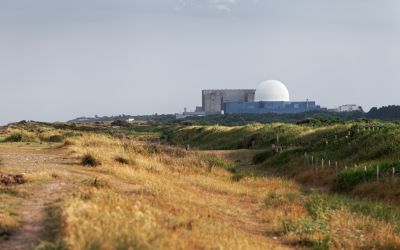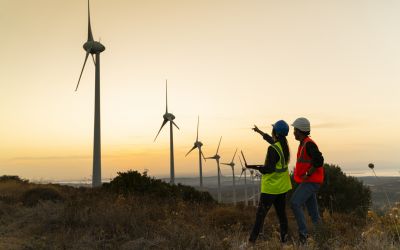Enel: Open Meter Reality
Open Meter is one of the innovative solutions promoted by the report produced by the WEF
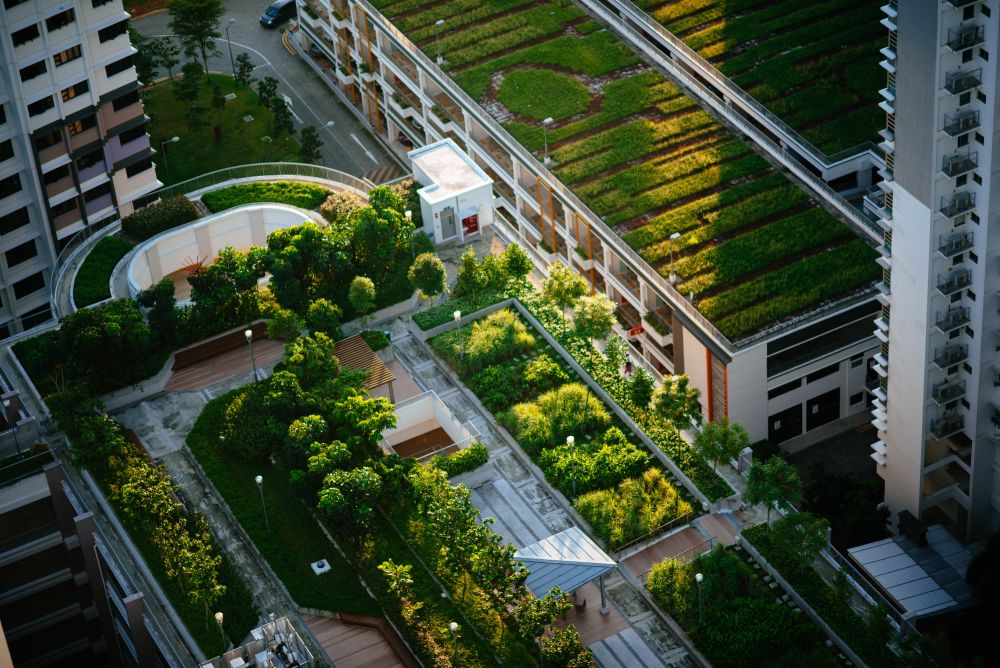
Open Meter is one of the innovative solutions promoted by the report produced by the WEF.
The reduction of carbon emissions must start with cities, with shared and harmonious choices. The report entitled "Universal solutions for Net Zero Carbon Cities" drawn up by the World Economic Forum (WEF), Schneider Electric and the Enel Group sets out concrete solutions towards this essential goal. The new report follows in the wake of the previous "Net Zero Carbon Cities - Systemic Efficiency Initiative" published in 2021. Since the launch of the initiative, Schneider and Enel have worked together with the community to accelerate the transition to zero emissions in 100 cities by 2030.
This series of high profile reports define the global problems and recommend an integrated energy approach, defined as "systemic efficiency", as a solution to the current environmental, economic, health and social crises. Systemic efficiency encompasses clean electrification, smart digital technology and efficient buildings and infrastructures, as well as a significant circular economy commitment to water, waste and materials.
Today's cities generate around 70% of the world's carbon dioxide emissions and consume 78% of the planet's energy. Decisive action must be taken to achieve the goal of limiting global warming to 1.5°C compared to pre-industrial levels by 2050. The contribution of cities to global CO2 emissions, aggravated by the growing trend towards urbanization, places metropolitan ecosystems as a prime testing ground for tackling the environmental challenges. Accelerating the urban transformation to reach the climate goals is essential. So what are the solutions?
A virtuous case study comes from within Enel itself. In the "Embed smart energy infrastructure" section the document commends the Open Meter. Smart Meters are a key means of analyzing consumers' demand for energy, remodeling behaviors through consumption data and the adoption of innovative digital functions. Smart measurement can also support the development of energy communities. Residential solar systems or other renewable resources can be connected to the Open Meter to help to measure the environmental impact, and utility companies can use the information to automate services such as bills and credits. Open Meter is an Enel project that will reach the homes of over 35 million Italian customers by 2025 and furthermore it is totally circular: it uses regenerated plastic.
The city initiative shows the need for an integrated approach to improve energy productivity, electrify transport, decarbonize heating and cooling systems and allow greater flexibility on the demand side, as well as providing concrete advice and sharing useful experience on these matters. Digitalization is the key for integrating the activities and ideas to make decarbonization a reality.
The route to a zero impact grid begins with directing the various stakeholders in the urban fabric towards a shared action program. The basic objective is to provide services efficiently and to develop a sustainable and resilient urban ecosystem.
Modern Power Systems
Can you summarise ENEL's smart meter experience to date, number of meters installed, locations?
The roll out of the first-generation of smart meters developed by Enel in the early 2000s (known as “Telegestore”) was one of the largest infrastructure innovations in Italy, as it became the first country in the world to have fully digital power grid. With its innovative features, the digital meter has brought simplicity and transparency, optimizing the contractual relationship of the customer with its electricity distributor and becoming the most "intelligent" device on the low-voltage grid. This innovative product was the first step towards a new generation of electric grids in which consumers and producers can benefit from advanced services focused on data accuracy, efficiency, and environmental protection.
Between 2001 and 2006, The “Telegestore” smart meter was installed by e-distribuzione for more than 32 millions customers connected to its distribution network. In addition to e-distribuzione, the first-generation smart meter was adopted by several Italian and foreign DSOs managing the energy distribution in some big cities (e.g. Milan, Malta, Cipro, Montenegro) for a total number of installed units higher than 36 millions.
In 2009, ENEL started the design and development of a new generation smart meters tailored for market other than Italy. The new smart meters family was called “Cervantes” and it was installed in field for the first time in Spain by ENDESA (a company of ENEL Group). The Cervantes smart meter introduced several evolutions with respect to Telegestore thanks to a more advanced PLC technology and leveraging the new Open communication protocol called “Meters and More” (managed by a non-profit Association). For the first time, the Cervantes smart meter solution enabled the massive collection of hourly load profiles for all the low-voltage customers connected via the smart meter thus enabling new market opportunities and generating strong benefits for the final customers in terms of tariffs, efficiency and flexibility.
Between 2010 and 2018, the Cervantes meter was installed by ENDESA for more than 12 millions customers.
Starting from 2015, the Cervantes smart meter was installed in many other countries by DSOs belonging to ENEL Group. Romania, Chile, Colombia, Peru, Argentina were involved in a first phase of smart meter deployment in order to demonstrate to the National Regulatory Authorities the benefits related to the adoption of such innovative technology.
Despite this great innovation, the evolution towards increasingly intelligent networks ("smart grids") and the new needs arising in the market have required Enel to go further and introduce additional features to benefit all market players: customers, prosumers, energy distributors, market operators, EV charging network operators, aggregators and the environment as well.
Based on the last 20 years’ experience and considering market and technological developments, the latest generation of Enel smart meters (“Open Meter Technology”) was developed few years ago allowing a real jump in the future. “Open Meter Technology” is a solution designed by Enel and implemented with leading edge technologies that enables future-proof abilities and functionalities that go beyond the simple concept of metering.
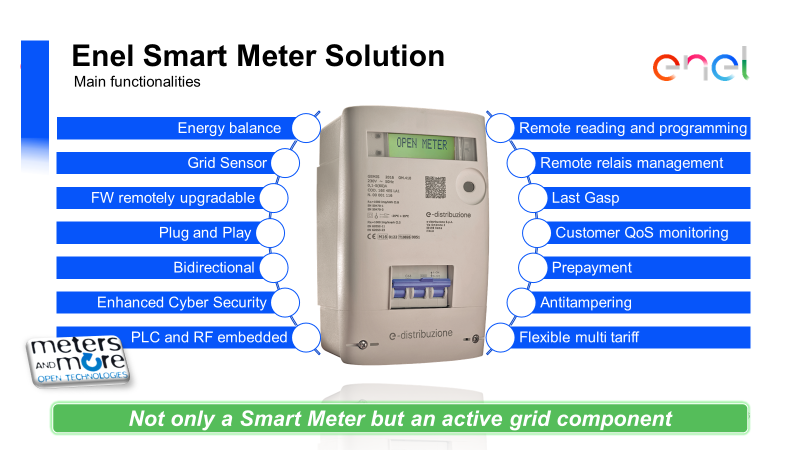
In 2018, ENEL started the design and development of an additional smart meter family tailored for the Brazilian market: JOBI smart meter family. In terms of functionalities, the JOBI smart meter is equivalent to Cervantes but equipped with new HW technologies for future evolutions.
The JOBI smart meter is being installed in Sao Paulo for the first pilot project of 300k units. A massive roll-out will follow in the next few years for more than 7 millions units.
The current status of smart meter installations in summarized in the chart below:
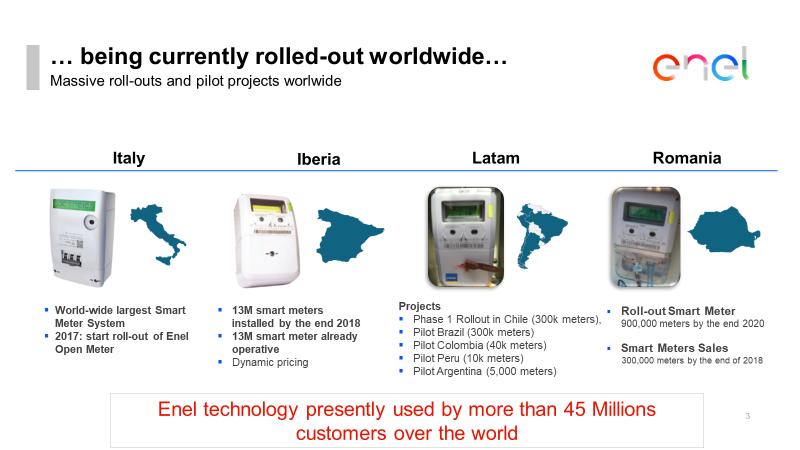
Taking into account the experience of ENEL Group starting from 2001, more than 85 millions smart meters have been manufactured and installed in field.
How has the technology developed over years?
The new generation of Enel smart meters introduces technological innovations to ensure high connectivity levels and completely new features creating a real breakthrough for the industry. Thanks to advanced measuring technologies and computational power, more and more granular energy data is now available to the customer and to the DSO, providing opportunities to better understand consumption habits and interact with other energy stakeholders. The daily acquisition of load profiles is enhanced making it possible to convey market offers with dynamic pricing and time of use tariffs that perfectly match the needs and behaviors of the electricity end users. By exploiting all the data that the new meter can manage and provide to the energy system, market operators (e.g. retailers) will be able to offer many value-added services in terms of both user profiling and commercial offers. Energy producers can also have a greater awareness of the efficiency of operation of their renewable plant enhancing a smarter integration of micro-generation in the grid.
“Open Meter” allows an advanced management of the technical parameters of the digital grid edge as well, acting as a real advanced sensor, allowing a pervasive monitoring of each individual installation point. This allows the Meter Operator to have detailed information for in-depth monitoring of the state of operation of the grid and to receive notifications in real time, thanks to a dedicated wireless channel (RF 169 MHz), in the case of events of particular interest such as power outages, for example. The advantage is to have two devices in one: an intelligent meter for commercial purposes and a network sensor for the real-time monitoring of the grid.
This new generation of sensors spread all over the distribution network, will allow Enel to collect, in Italy alone, more than 7.000 billions data every year. This information can then be used in order to optimize network operations (by predictive maintenance, load balancing and revenue protection) and improve quality of service and efficiency of operations. The Smart Meters take a relevant role in the digitalization of distribution networks, as well, translating network electrical parameters into digital information that forms a relevant part of our Network Digital Twin® and Grid Futurability (R) technological platforms.
The newest generation of smart meters has also been designed with a special consideration to the environment and circular economy. These new devices can indeed be fully manufactured using recycled plastic materials coming from the first-generation smart meters, ensuring a circular approach. This represents an additional Enel’s step forward towards a more sustainable future.
But perhaps the most meaningful innovation of the second-generation smart meters is that they take customer empowerment to the next level thanks to advanced communication capabilities with the customers’ houses in near real-time. A dedicated communications channel in the meter, also known in Italy as "Chain 2", allows the development and diffusion of commercial solutions dedicated to energy management services and home automation. A wide variety of information can be made available through this channel - not available previously on the first-generation meters – allowing customers to gain more awareness and understanding of their consumption. This feature will be a strong enabler for the smart energy customers that will take an active role in the energy market. The data and notifications sent by the smart meters to the customer premises can be shared, if the customer wishes to do so, with third-parties to develop tailored offers and new services like load management, demand-response and energy efficiency support integrated, for instance, with their domotic system. In terms of use cases, this feature can be exploited, for example, for the modulation of the available power used to recharge our electric vehicle based on the consumption measured for the home appliances (and considering the maximum contractual power) or start the washing machine when the meter notifies the activation of the off-peak tariff.
Another benefit of the “Chain 2” is based on the use of power-line technology (PLC), a solution that allows to transmit data on the same cables that brings energy to the customer premises thus avoiding any need to modify the home installation for receiving consumption data.. Thanks to this, smart meters can also communicate with the so-called smart “In-Home-Devices" connected to the customer’s electrical installation , allowing the acquisition of different energy data parameters in near real-time conditions. Any electronic device manufacturer can easily built-in data exchange capabilities, thus opening a new market in the electronic world and allowing end-users to develop their own smart-home ecosystem.
What lessons have been learned?
The Italian first-generation smart metering system had a strong and fast success. The payback time was within four years while the technology guaranteed for 15 years. The experience proved a high level of reliability, with no relevant replacements due to faults (the experience gained in 15 years operation has demonstrated that static meters assure strong reliability in terms of metrology performances and durability). Thanks to the new devices, the Italian DSOs managed more than 97% of the served customers remotely, with a consequent strong reduction of the operational costs. For the remaining 3% the telecommunications technologies were not able to collect metering data, hence implying the intervention of in-field personnel (only when needed).
The first-generation architecture was based on a two-step data acquisition process: firstly, data stored in the meters were gathered locally thanks to an intermediate device called concentrator. Generally, the concentrator acts as the master node for all the smart meters of the served LV network and is the interface for the communication with the Head-End System (HES) of the DSO. The telecommunications technology used by all the Italian DSOs between meters and concentrators was the Power Line Communications (PLC). Secondly, the concentrator forwarded the gathered data to the HES of the DSO using cellular solutions. Such architecture has provided very good results in terms of efficiency (data concentrators represent a distributed intelligence that can optimize management processes) and effectiveness (data is stored by the in-field devices and transferred when the communication channel is available). Nevertheless, improvements to the communication technologies have been considered due to minor problems rose both from the cellular coverage but also from the interferences revealed on the PLC carrier. The origin of these interferences was mainly due to appliances built with electronic switches e.g. inverters, devices’ chargers, led bulbs, etc. Based on this facts, the opportunity for a backup communication channel has been considered for the new generation systems currently under deployment in Italy.
Although all the reached successes, the gained 15-years’ experience revealed some drawbacks. The most relevant was the lack of a standard interface and a dedicated communication channel to promptly inform the customer about near real-time electricity consumption and production, as required by Recommendation n. 2012/148/EU. According to settlement regulation in Italy, energy registers were collected on a monthly basis by DSOs, validated and forwarded to retailers for the billing process. Generally, considering the time needed for the invoicing process, the customer received the total calculation of the energy exchanged with the network and the corresponding bill after some weeks in an aggregated manner.
Another limitation was the slow reconfiguration process required to update the devices’ firmware, due to traditional architecture of the HES that was not able to assure high level of parallelization for update activities.
About quality of service, the information available in terms of voltage (interruptions and variations) was not fully exploitable due to a buffer of events too short (limited statics).
From the market point of view, Retailers and 3rd party service providers developed a wide set of new services and offers thanks to which the energy market has gained strong competitive dynamism (millions of customers migrated to the free market of energy). Nevertheless, some improvements have been identified in terms of information availability that would enable even stronger offers in a scenario where distributed generation, demand-response and electric vehicle represents the next generation appliances to the served by the energy market.
Based on these lessons learned, the Open Meter Technology and the following solutions were introduced.
Other relevant lessons learned are summarized below:
- The smart meter technology shall be adopted with a massive approach in order to assure the best benefits to the energy system and to the community. This also avoid discrimination among customers that can access to the same level of services;
- The massive roll-out shall be implemented as fast as possible. This minimizes the inefficiency related to the simultaneous management of the metering systems (traditional and smart one);
- The Community is the best ally of the smart meter technology. It is important to engage the customers for the adoption of such technology since it assures the achievement of the benefits in terms of market flexibility, new tariffs adoption, etc;
- The smart meter technology shall consider the important role of the customers and their education to a good use of the energy. The smart meter solution shall include specific features in order to share with customers relevant information about energy consumption so that they can adopt improved behaviours for a more sustainable use of the energy;
How has the role of smart meters evolved since the early installations?
The new generations of smart meter have been designed to be true network sensors, able to collect detailed information in case of relevant network events (i.e. voltage interruption, voltage restoration, fault conditions etc), reducing the time of intervention on outages and ensuring an efficient network operation.
In Italy, the ongoing replacement of 32 million first-generation smart meters with new ones is establishing a sort of “nervous system” of the electric network 2.0. A smart grid in which customer smart metering systems are more and more interconnected with distribution grid devices, allowing remote control and network automation enhancement. By means of this integration and the evolution of grid management algorithms as well as grid edge computational power, the infrastructure will be increasingly resilient, and capable of guaranteeing an efficient operation in all conditions, providing a high quality level of services to all our end-users.
That’s why smart meters can fast forward our energy future and help build more resilient, participatory and sustainable grids.
Current projects, eg, in Brazil?
In terms of smart metering technologies, the current projects ongoing in ENEL are:
- ITALY: massive roll-out of the Open Meter project ongoing. More than 21 millions Open Meters installed to date. The massive roll-out of 32 millions meters will be completed in 2024;
- ROMANIA: massive roll-out of the smart meters ongoing. More than 900k smart meters installed to date. The massive roll-out of 2.4 millions smart meters will be completed in 2026;
- BRAZIL: pilot project of JOBI smart meters ongoing. More than 100k smart meters installed to date. The pilot project (300k units) will be completed in 2022. In 2022, the massive roll-out will start in order to replace more than 7 millions meters within 2026;
- CHILE: massive roll-out to be started in 2022 according to National Regulation;
Next steps?
ENEL Group has the main goal to adopt smart meters for 100% of customers connected to its distribution networks within 2030. By this way, ENEL Group has always a strong focus in promoting such technology in all the countries of presence trying to demonstrate the real benefits and supporting NRA for the evaluation of cost-benefits analysis that can justify such investment.
In the meantime, ENEL is continuously working on innovating its smart metering portfolio adopting cutting-edge technologies and enriching the set of features and benefits offered.
In terms of vision (as already mentioned above), the smart metering technology will evolve towards an IoT approach where the meters will be considered distributed sensors on the edge, always connected and able to interact with external devices in order to enable new services oriented to flexibility and to the active role of customers in the energy market.
Climate Action is officially partnering with the event “Grid Futurability ® for a Net-Zero World” organized by Enel as part of the Pre-COP All4Climate - Italy 2021. The event will discuss the transformation of traditional distribution networks into Smart Grids, combining the use of robust infrastructure with advanced digital solutions that make electricity grids more resilient, participatory and sustainable. Register your interest here.


_400_250_s_c1.png)
